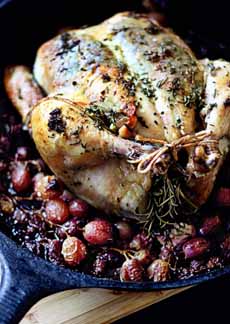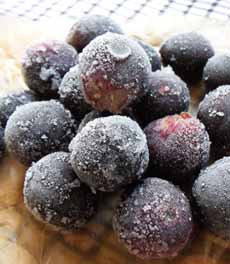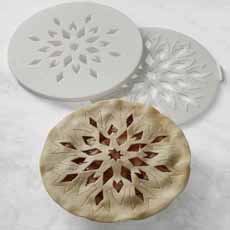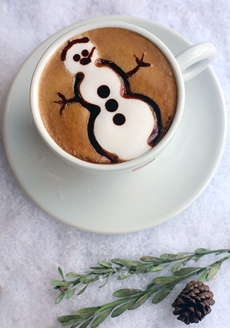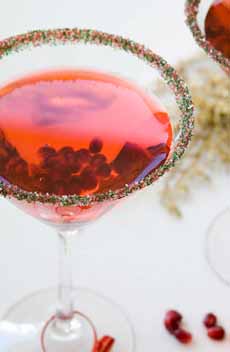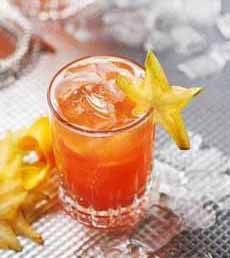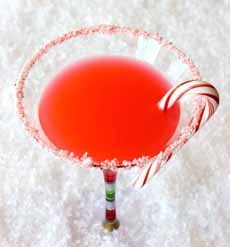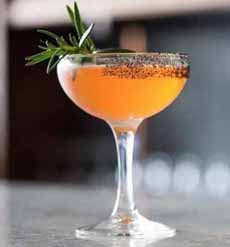
[1] A mezcal cocktail rimmed with a deep half rim, a blend of chipotle and black lava salt (at Olmsted | Brooklyn).
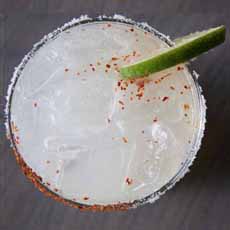
[2] A full rim covering just the top of the glass, with two different seasonings: half salt, half Tajin (at Alma Cocina Latina | Baltimore).
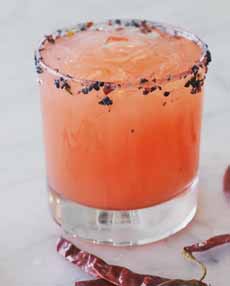
[3] A Thai Margarita rimmed with a blend of black lava salt and hibiscus leaves (at Miro Kitchen | Fairfield, Connecticut).

[4] A Magic Shell rim (at Gordon Ramsay Group).
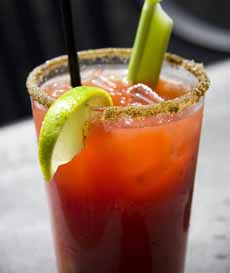
[5] A celery salt rim on a Bloody Mary (at Pompeian | Facebook) A current favorite is Tajin seasoning.
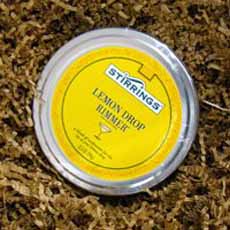
[6] A tin of Lemon Drop cocktail rimmer (photo © The Party Source).
|
|
Make your cocktails more interesting with cocktail glass rimmers. The original cocktail glass rimmer, as far as we know, was the coarse salt on a Margarita glass in 1948. According to Margarita history, it was created in 1948, adapting a long-standing Mexican tradition of a shot of tequila served with a lime wedge and salt.
With the Margarita, the salt rim was visually appealing and added flavor to the drink. Maybe—we can’t find data to substantiate—someone put celery salt on a Bloody Mary rim (photo #5); but the practice was not widespread.
Why it took so long for other glass rims to emerge is anyone’s guess. But some 15 years ago, we first noticed a product called a glass rimmer at the annual specialty food show.
The pioneers were Stirrings and Nantucket Offshore, manufacturers of premium cocktail ingredients. Others followed (you can see them on Amazon.com).
Shallow round tins (photo #6) contained different savory or sweet blends for popular drinks: Bloody Mary, Cosmopolitan, Lemon Drop, and so on.
The rim of the cocktail glass was moistened and twisted in the tin to coat it. Non-cocktail rimmers for hot chocolate and other drinks followed.
Bartenders noticed; and over the years, creative mixologists proceeded to elevate glass rimmers into an art—owing largely to the accessibility of unusual ingredients, from black lava salt to hibiscus leaves.
The rim can be as minimal or deep as the mixologist desires (compare photos #1, #2, and #3).
The most recent evolution is half- or three-quarter rims, which give the drinker the option to partake of the rim seasoning or not.
March 24th is National Cocktail Day.
MIX AND MATCH RIMS
As you peruse the lists below, consider combining ingredients; for example:
Chile powder and lemon zest
Chopped nuts and shaved chocolate
Cocoa powder and chile powder
Cracked pepper and thyme
Lemon zest and sparkling sugar
You can make the rims seasonal—for example, orange zest and black lava salt for Halloween, and crushed candy canes for the holidays.
The variations are endless, and give you the creativity to layer the flavors you want.
SAVORY COCKTAIL RIMS
Celery salt
Cracked or ground pepper
Crushed dried chiles: cayenne, chipotle, jalapeño, red pepper flakes
Dried herb blends: thyme, oregano, sage
Flower petals, dried hibiscus leaves
Pink or green peppercorns
Seasoned salts, Tajin
Specialty salts: black lava salt, pink salt, red lava salt, smoked salt, wasabi salt
Spices: Asian blend, chili powder, cumin, herbes de provence, Italian blend, oregano, powdered cloves, thyme, etc.
SWEET COCKTAIL RIMS
Chocolate shell
Citrus zest
Chopped nuts
Cocoa powder, cocoa drink mix
Cookie crumbs
Crushed hard candies—butterscotch, peppermint, etc.
Edible glitter
Ground coffee beans
Mini chocolate chips
Sugar: coarse sugar (decorator’s sugar, sanding sugar), white, colored, sparkling; cinnamon sugar; powdered sugar
Shaved chocolate, chocolate sprinkles
Shredded coconut
Spices: cinnamon sugar, gingerbread spice, pumpkin pie spice
NON-ALCOHOLIC DRINKS
You can use rims on other drinks, for example:
Shredded coconut on a cup of hot chocolate
Cookie crumbs on a glass of milk
Cinnamon sugar on a glass of iced coffee
Herbs, seasoned salts or zest on vegetable juice
HOW TO ADHERE THE RIM
Beyond the original adherent—water—mixologists now add another layer of flavor using flavorful adherents.
Orange juice, lemon juice, or other juice (apple, mango, pomegranate, vegetable, you name it) can substitute for water.
|
|
For sweet cocktails, the rim can be affixed with honey, maple syrup, or simple syrup (sugar syrup), among other syrups.
For dessert cocktails, you can use caramel or chocolate sauce, even marshmallow cream (we’ve enjoyed a particularly calorie-packed Piña Colada with a rim of marshmallow cream and toasted coconut).
The next time you pour a cocktail at home, first add a rim. Put the adherent liquid in a shallow bowl, and the rimming ingredient (herbs, sugar, etc.) on a saucer.
Dip the glass into the liquid about 1/4 inch deep (or however deep you want the rim).
Then, just place the glass on the dish with the ingredients, and twist to coat.
You’re now an expert rimmer of drinks!
CHECK OUT WHAT’S HAPPENING ON OUR HOME PAGE, THENIBBLE.COM.
|


